Communication Models and Methods in Business
VerifiedAdded on 2023/02/03
|19
|1407
|21
Presentation
AI Summary
This presentation discusses communication models and methods used in business for effective communication. It covers the principles of simplicity, clarity, brevity, planning, accuracy, attentiveness, and relevancy. It also explores barriers to communication and provides strategies to overcome them.
Contribute Materials
Your contribution can guide someone’s learning journey. Share your
documents today.
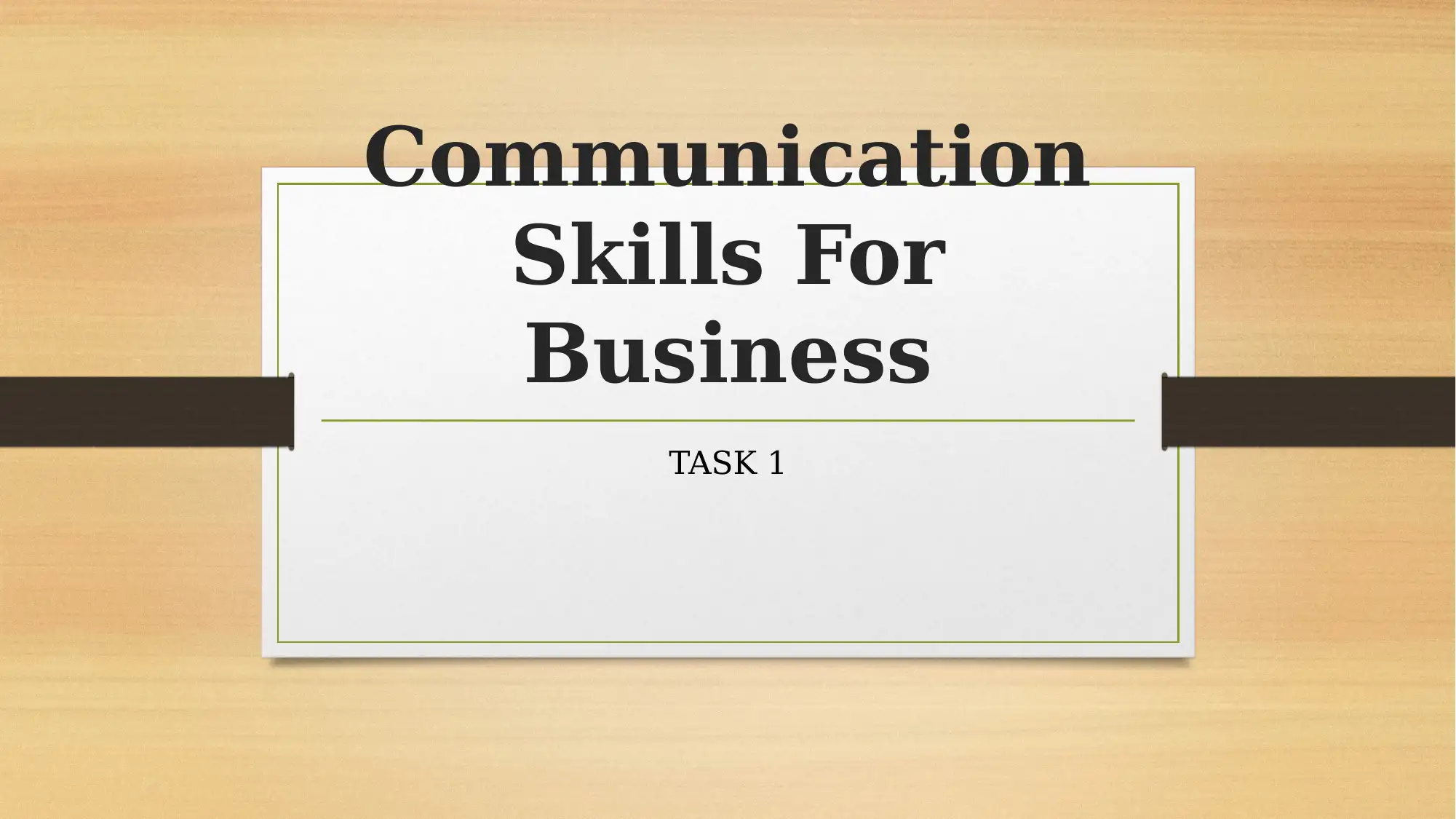
Communication
Skills For
Business
TASK 1
Skills For
Business
TASK 1
Secure Best Marks with AI Grader
Need help grading? Try our AI Grader for instant feedback on your assignments.
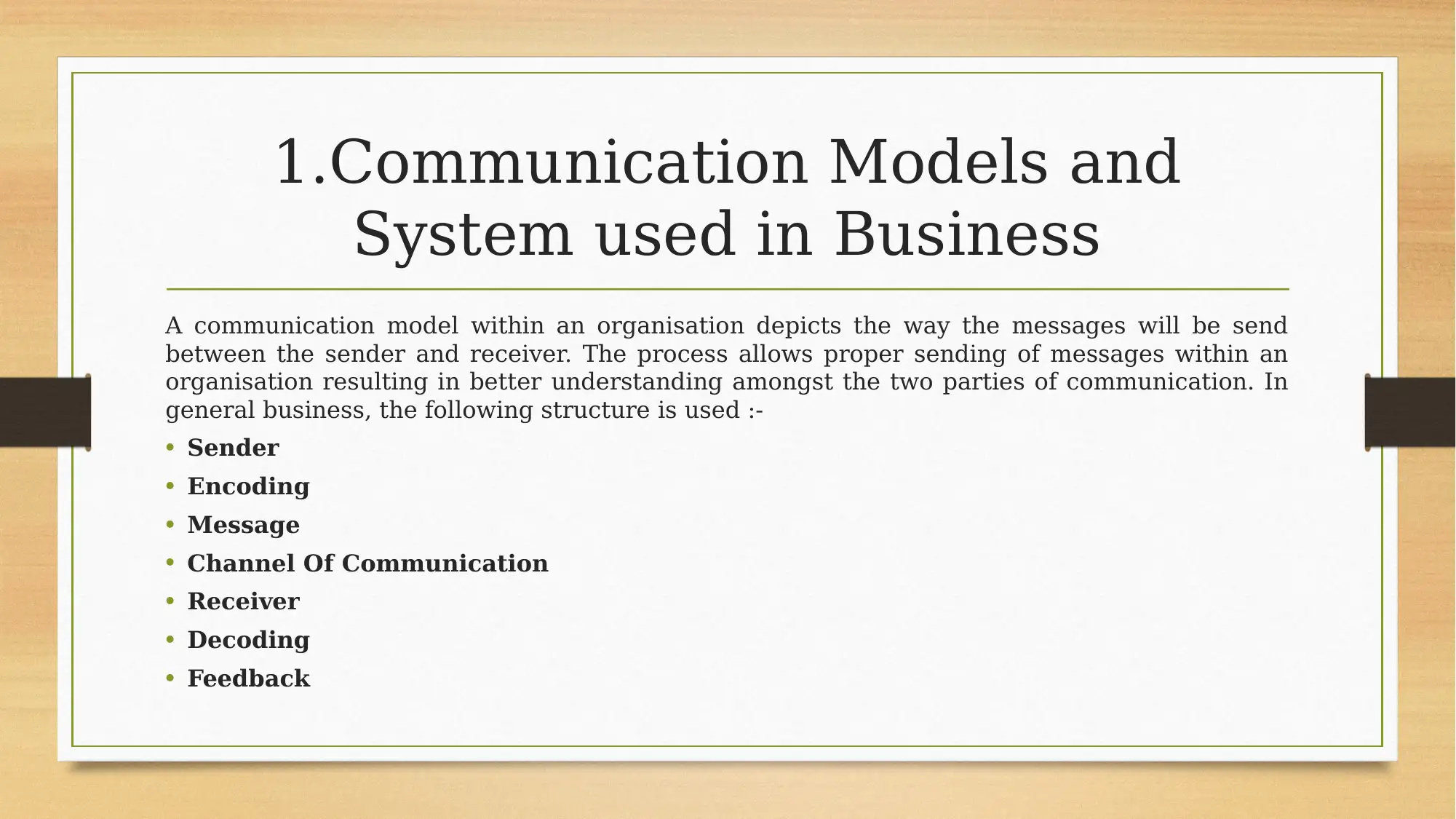
1.Communication Models and
System used in Business
A communication model within an organisation depicts the way the messages will be send
between the sender and receiver. The process allows proper sending of messages within an
organisation resulting in better understanding amongst the two parties of communication. In
general business, the following structure is used :-
• Sender
• Encoding
• Message
• Channel Of Communication
• Receiver
• Decoding
• Feedback
System used in Business
A communication model within an organisation depicts the way the messages will be send
between the sender and receiver. The process allows proper sending of messages within an
organisation resulting in better understanding amongst the two parties of communication. In
general business, the following structure is used :-
• Sender
• Encoding
• Message
• Channel Of Communication
• Receiver
• Decoding
• Feedback
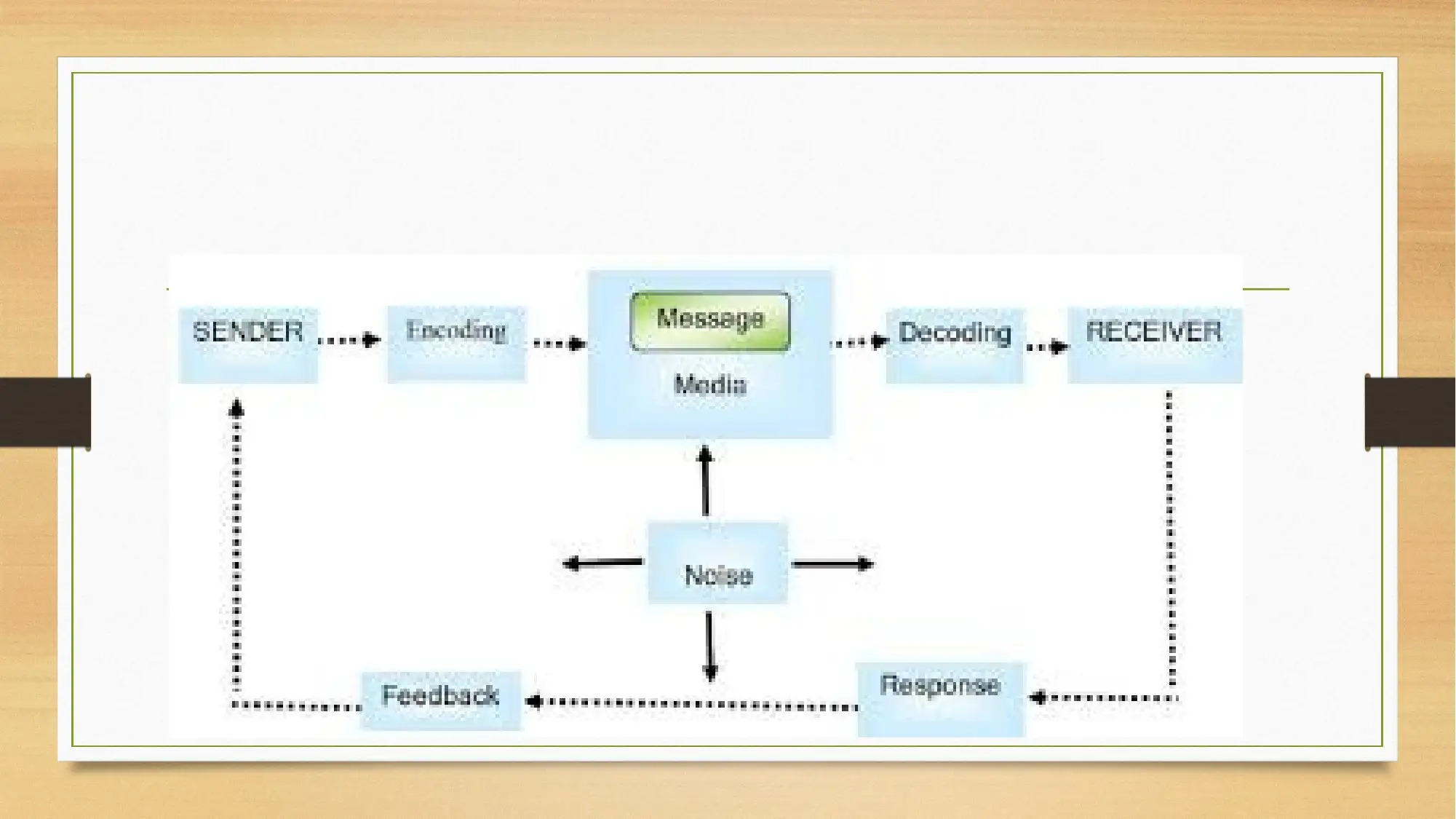
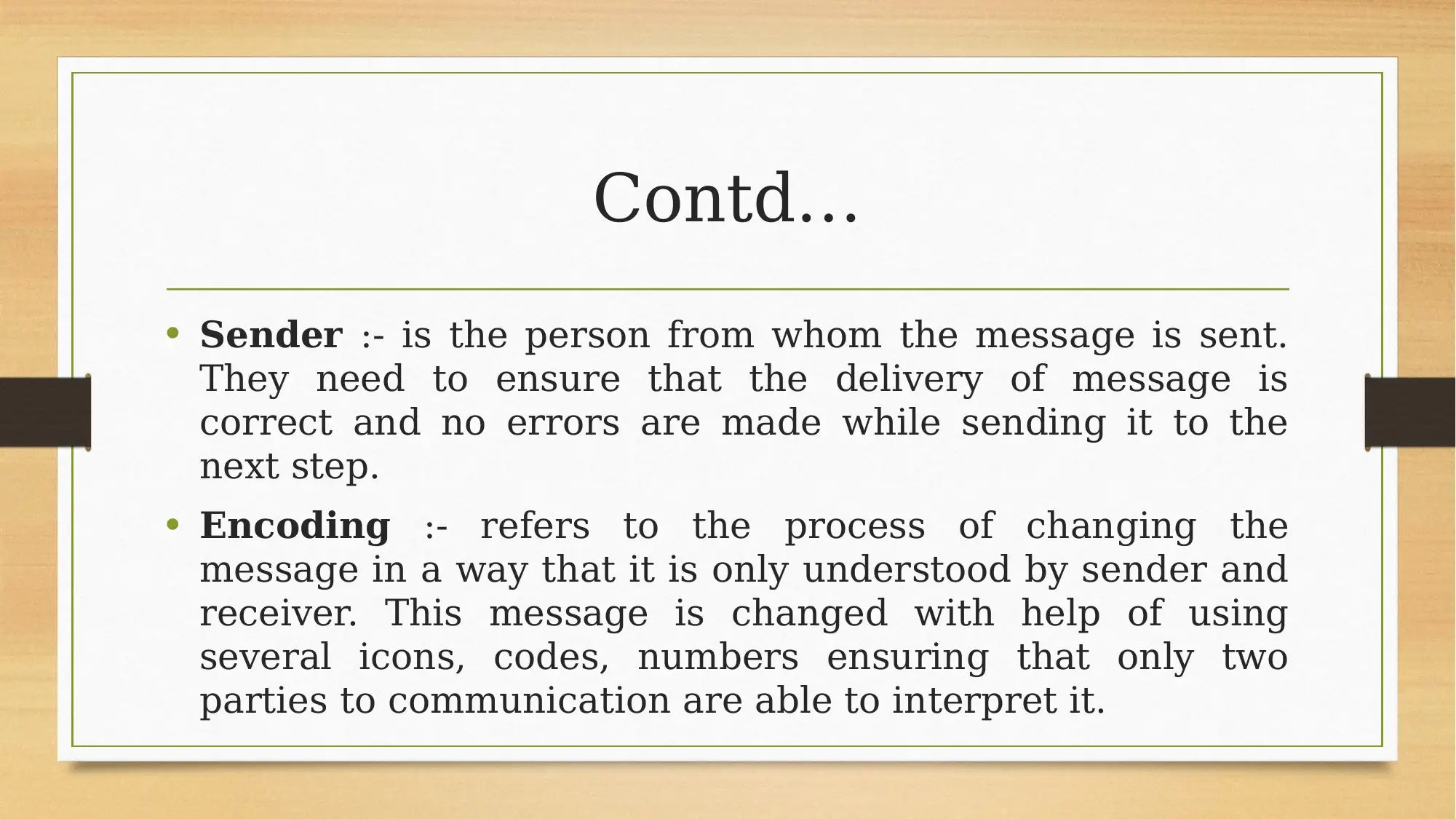
Contd…
• Sender :- is the person from whom the message is sent.
They need to ensure that the delivery of message is
correct and no errors are made while sending it to the
next step.
• Encoding :- refers to the process of changing the
message in a way that it is only understood by sender and
receiver. This message is changed with help of using
several icons, codes, numbers ensuring that only two
parties to communication are able to interpret it.
• Sender :- is the person from whom the message is sent.
They need to ensure that the delivery of message is
correct and no errors are made while sending it to the
next step.
• Encoding :- refers to the process of changing the
message in a way that it is only understood by sender and
receiver. This message is changed with help of using
several icons, codes, numbers ensuring that only two
parties to communication are able to interpret it.
Secure Best Marks with AI Grader
Need help grading? Try our AI Grader for instant feedback on your assignments.
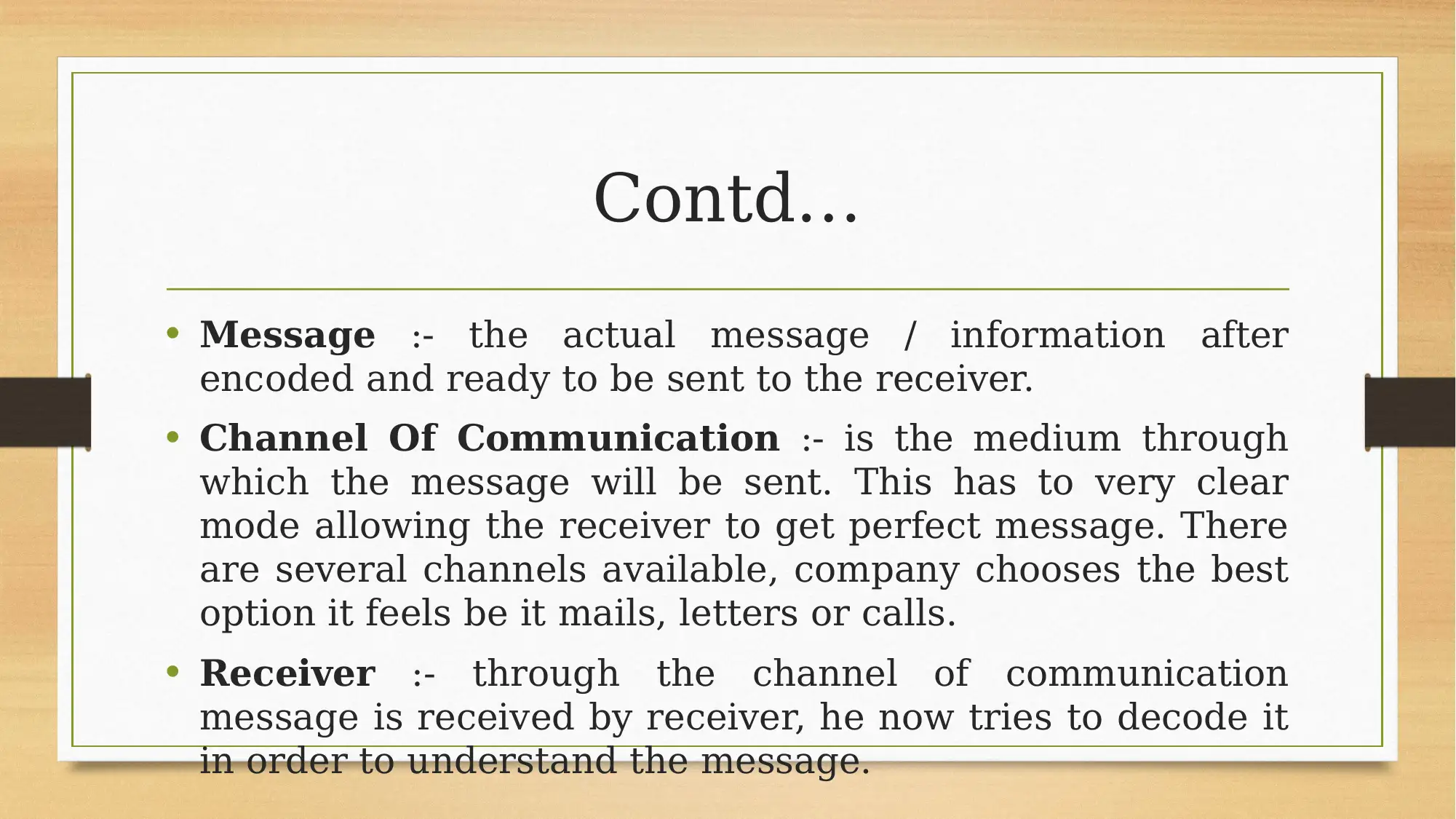
Contd…
• Message :- the actual message / information after
encoded and ready to be sent to the receiver.
• Channel Of Communication :- is the medium through
which the message will be sent. This has to very clear
mode allowing the receiver to get perfect message. There
are several channels available, company chooses the best
option it feels be it mails, letters or calls.
• Receiver :- through the channel of communication
message is received by receiver, he now tries to decode it
in order to understand the message.
• Message :- the actual message / information after
encoded and ready to be sent to the receiver.
• Channel Of Communication :- is the medium through
which the message will be sent. This has to very clear
mode allowing the receiver to get perfect message. There
are several channels available, company chooses the best
option it feels be it mails, letters or calls.
• Receiver :- through the channel of communication
message is received by receiver, he now tries to decode it
in order to understand the message.

Contd…
• Decoding :- refers to the process of bringing back
message to its original form. Correcting all the icons,
numbers etc. allowing receiver to interpret what sender is
trying to communicate.
• Feedback :- after receiving the message, the receiver
send a feedback to sender with the validation that they
have understood the message and will act accordingly.
• Decoding :- refers to the process of bringing back
message to its original form. Correcting all the icons,
numbers etc. allowing receiver to interpret what sender is
trying to communicate.
• Feedback :- after receiving the message, the receiver
send a feedback to sender with the validation that they
have understood the message and will act accordingly.
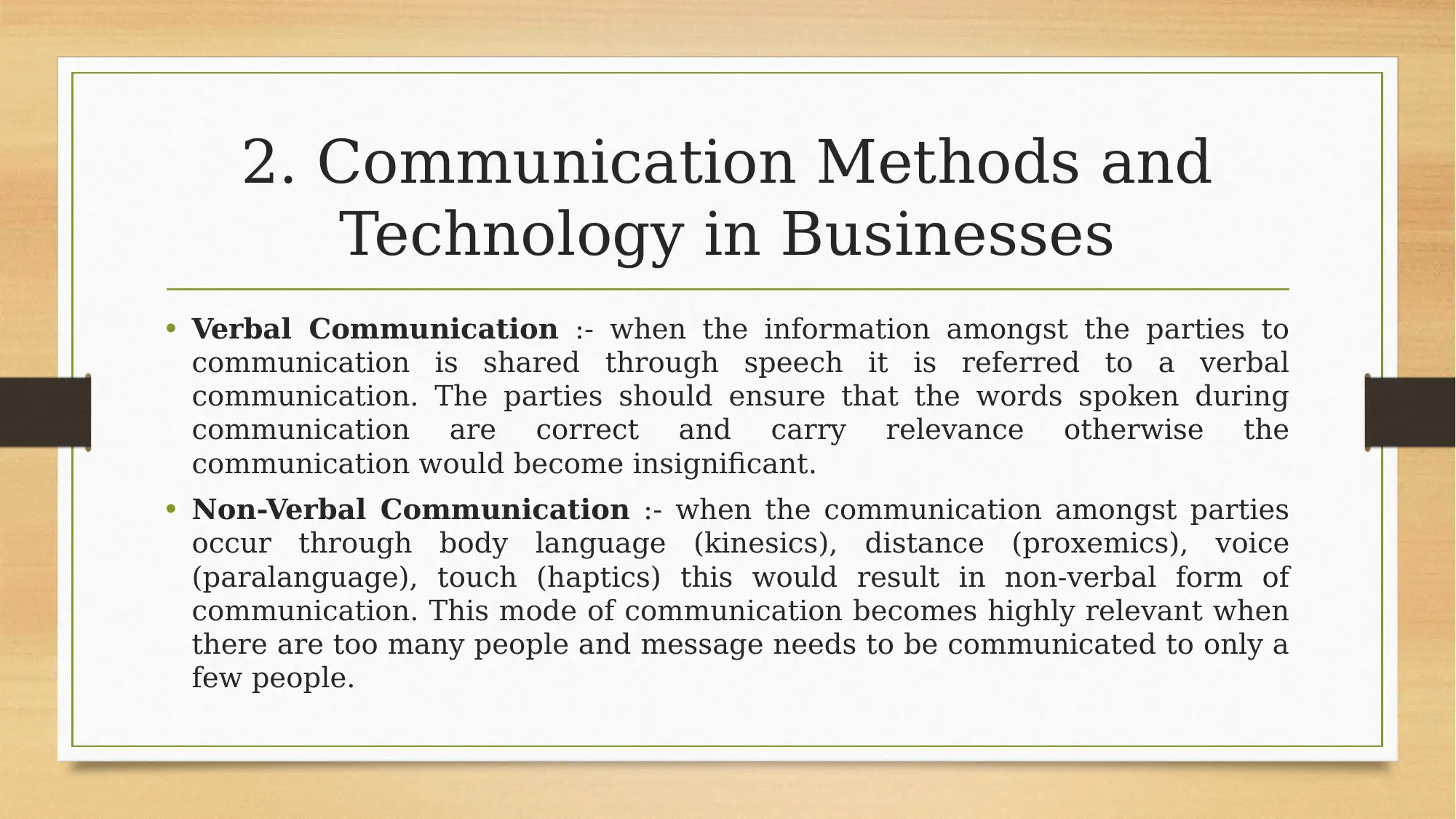
2. Communication Methods and
Technology in Businesses
• Verbal Communication :- when the information amongst the parties to
communication is shared through speech it is referred to a verbal
communication. The parties should ensure that the words spoken during
communication are correct and carry relevance otherwise the
communication would become insignificant.
• Non-Verbal Communication :- when the communication amongst parties
occur through body language (kinesics), distance (proxemics), voice
(paralanguage), touch (haptics) this would result in non-verbal form of
communication. This mode of communication becomes highly relevant when
there are too many people and message needs to be communicated to only a
few people.
Technology in Businesses
• Verbal Communication :- when the information amongst the parties to
communication is shared through speech it is referred to a verbal
communication. The parties should ensure that the words spoken during
communication are correct and carry relevance otherwise the
communication would become insignificant.
• Non-Verbal Communication :- when the communication amongst parties
occur through body language (kinesics), distance (proxemics), voice
(paralanguage), touch (haptics) this would result in non-verbal form of
communication. This mode of communication becomes highly relevant when
there are too many people and message needs to be communicated to only a
few people.
Paraphrase This Document
Need a fresh take? Get an instant paraphrase of this document with our AI Paraphraser
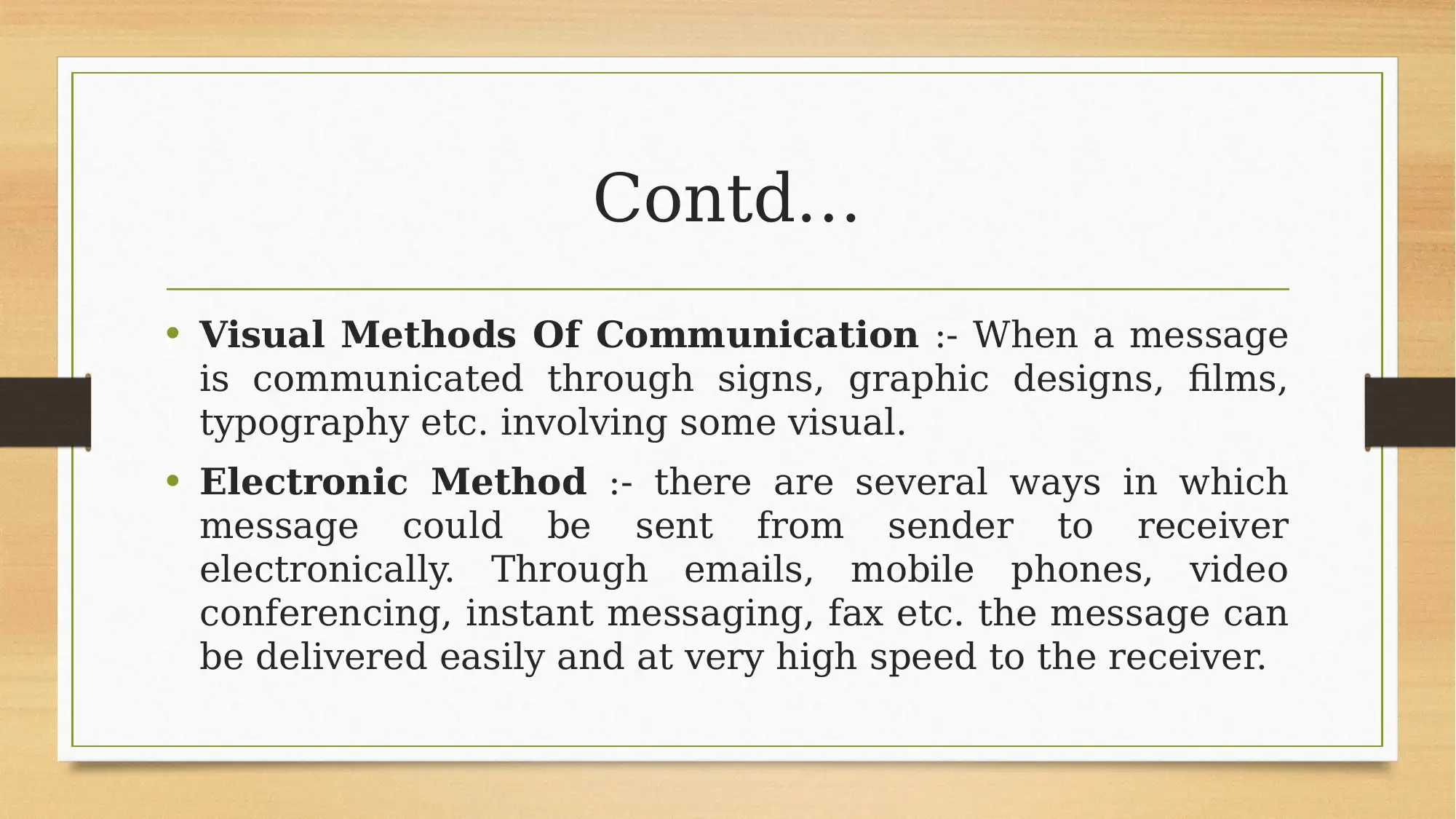
Contd…
• Visual Methods Of Communication :- When a message
is communicated through signs, graphic designs, films,
typography etc. involving some visual.
• Electronic Method :- there are several ways in which
message could be sent from sender to receiver
electronically. Through emails, mobile phones, video
conferencing, instant messaging, fax etc. the message can
be delivered easily and at very high speed to the receiver.
• Visual Methods Of Communication :- When a message
is communicated through signs, graphic designs, films,
typography etc. involving some visual.
• Electronic Method :- there are several ways in which
message could be sent from sender to receiver
electronically. Through emails, mobile phones, video
conferencing, instant messaging, fax etc. the message can
be delivered easily and at very high speed to the receiver.
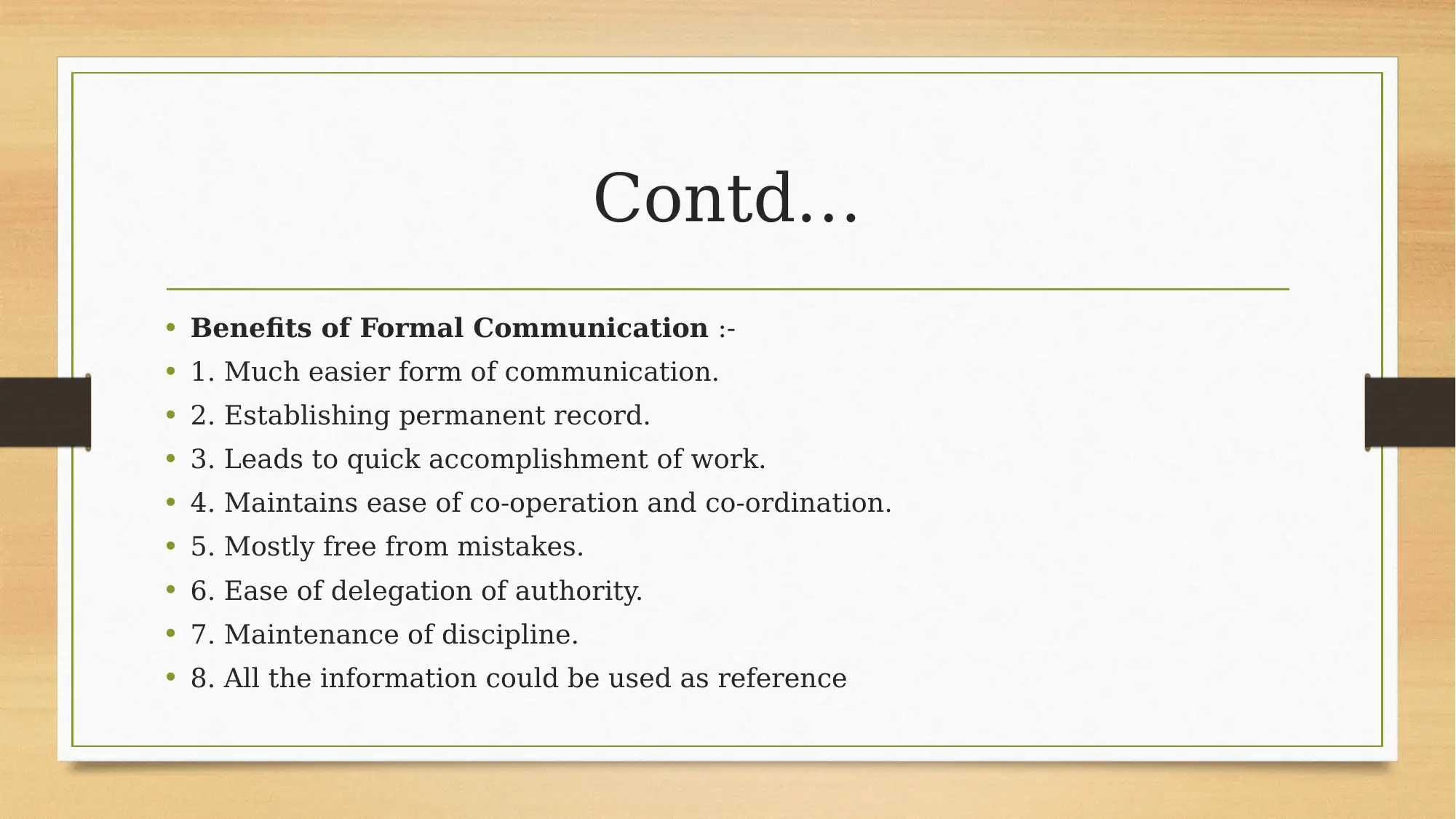
Contd…
• Benefits of Formal Communication :-
• 1. Much easier form of communication.
• 2. Establishing permanent record.
• 3. Leads to quick accomplishment of work.
• 4. Maintains ease of co-operation and co-ordination.
• 5. Mostly free from mistakes.
• 6. Ease of delegation of authority.
• 7. Maintenance of discipline.
• 8. All the information could be used as reference
• Benefits of Formal Communication :-
• 1. Much easier form of communication.
• 2. Establishing permanent record.
• 3. Leads to quick accomplishment of work.
• 4. Maintains ease of co-operation and co-ordination.
• 5. Mostly free from mistakes.
• 6. Ease of delegation of authority.
• 7. Maintenance of discipline.
• 8. All the information could be used as reference
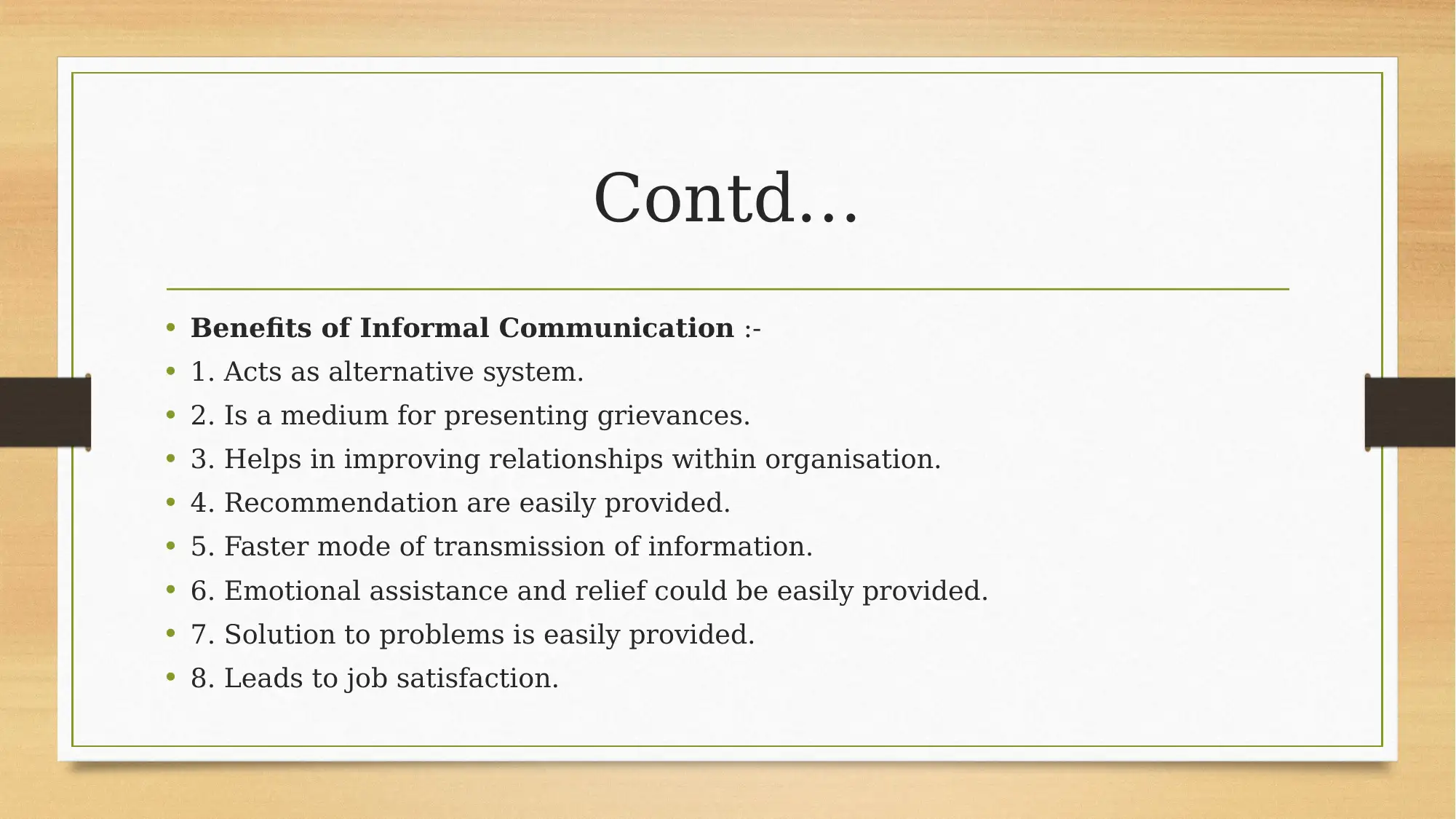
Contd…
• Benefits of Informal Communication :-
• 1. Acts as alternative system.
• 2. Is a medium for presenting grievances.
• 3. Helps in improving relationships within organisation.
• 4. Recommendation are easily provided.
• 5. Faster mode of transmission of information.
• 6. Emotional assistance and relief could be easily provided.
• 7. Solution to problems is easily provided.
• 8. Leads to job satisfaction.
• Benefits of Informal Communication :-
• 1. Acts as alternative system.
• 2. Is a medium for presenting grievances.
• 3. Helps in improving relationships within organisation.
• 4. Recommendation are easily provided.
• 5. Faster mode of transmission of information.
• 6. Emotional assistance and relief could be easily provided.
• 7. Solution to problems is easily provided.
• 8. Leads to job satisfaction.
Secure Best Marks with AI Grader
Need help grading? Try our AI Grader for instant feedback on your assignments.
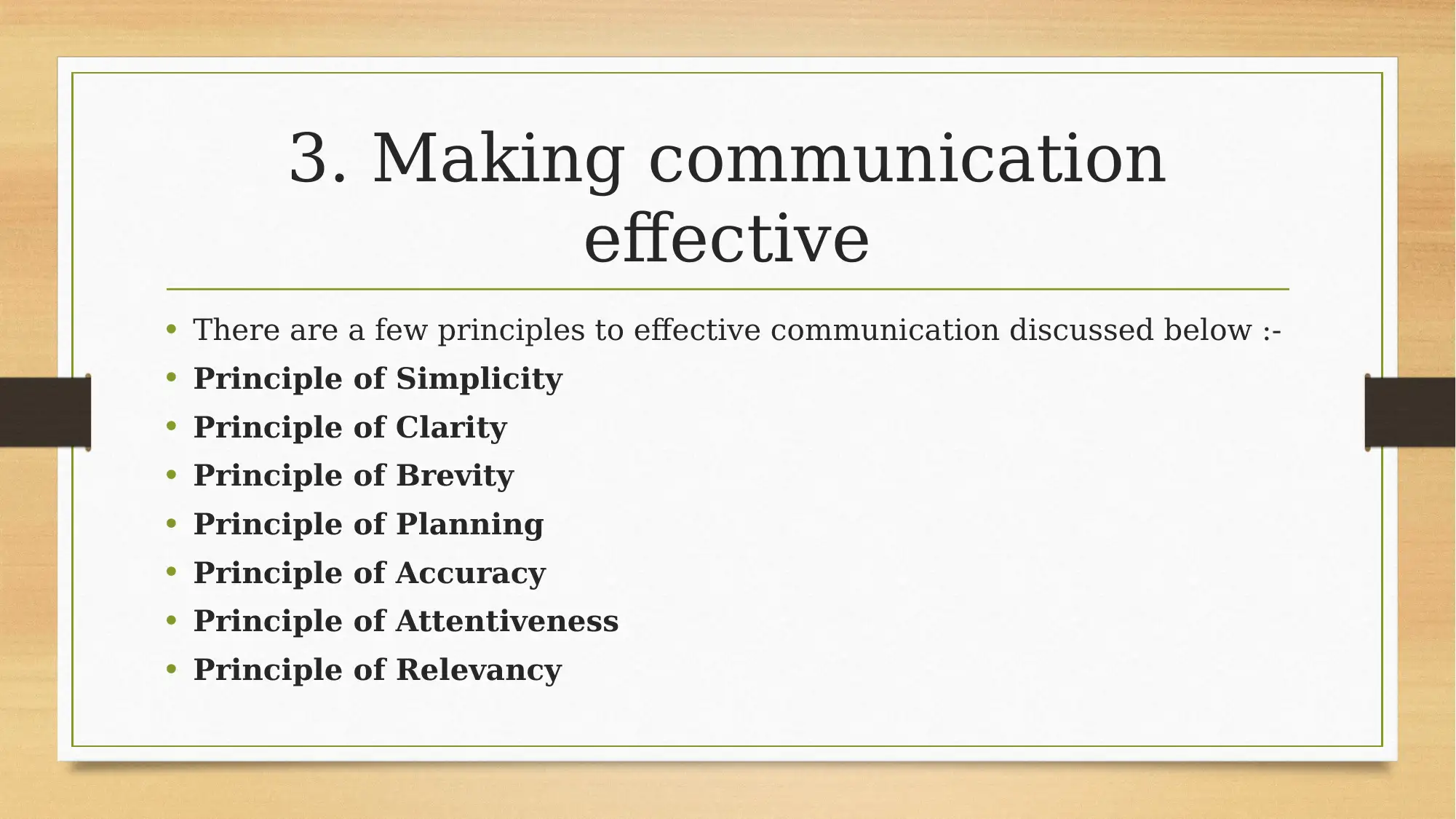
3. Making communication
effective
• There are a few principles to effective communication discussed below :-
• Principle of Simplicity
• Principle of Clarity
• Principle of Brevity
• Principle of Planning
• Principle of Accuracy
• Principle of Attentiveness
• Principle of Relevancy
effective
• There are a few principles to effective communication discussed below :-
• Principle of Simplicity
• Principle of Clarity
• Principle of Brevity
• Principle of Planning
• Principle of Accuracy
• Principle of Attentiveness
• Principle of Relevancy
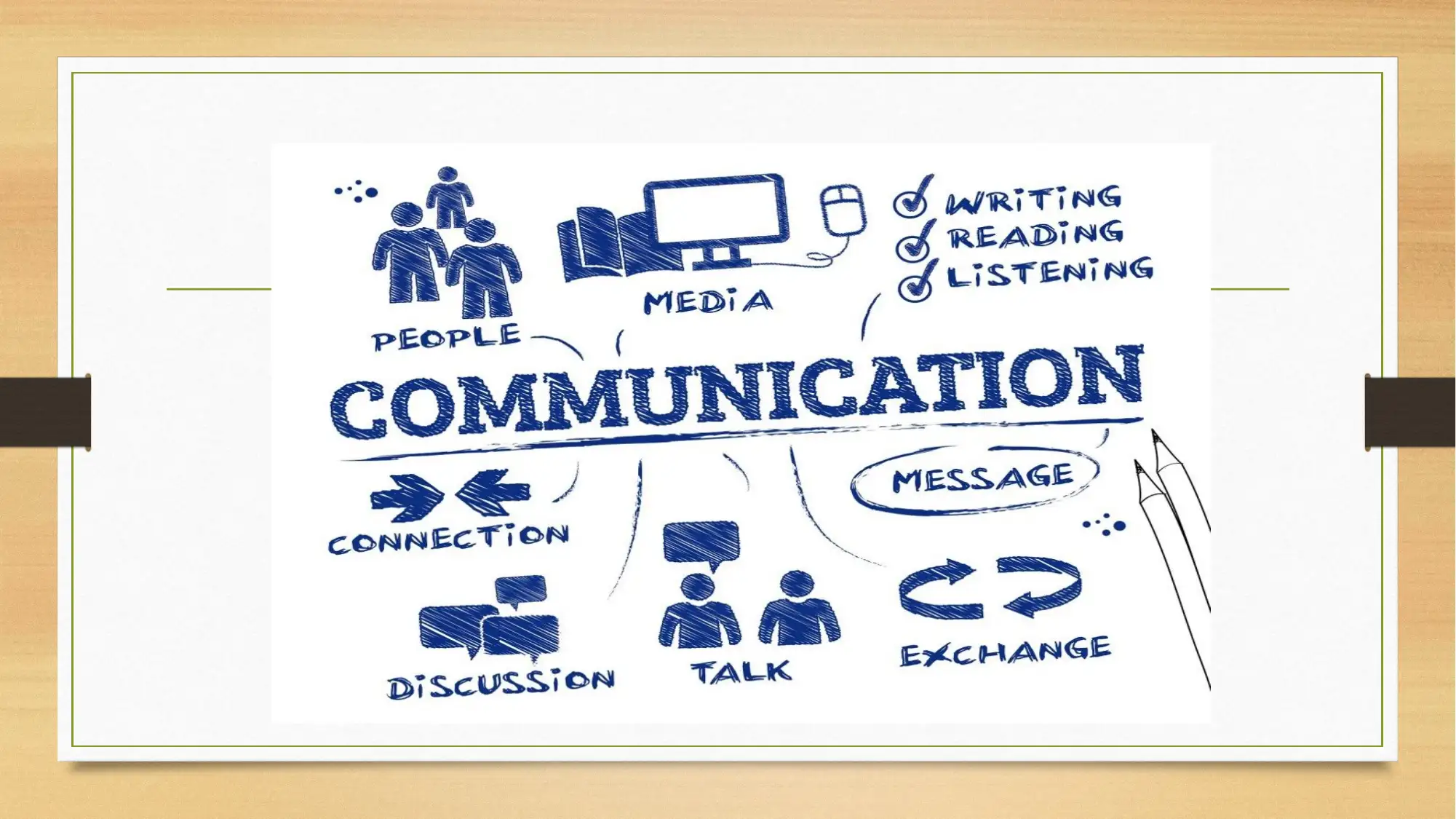
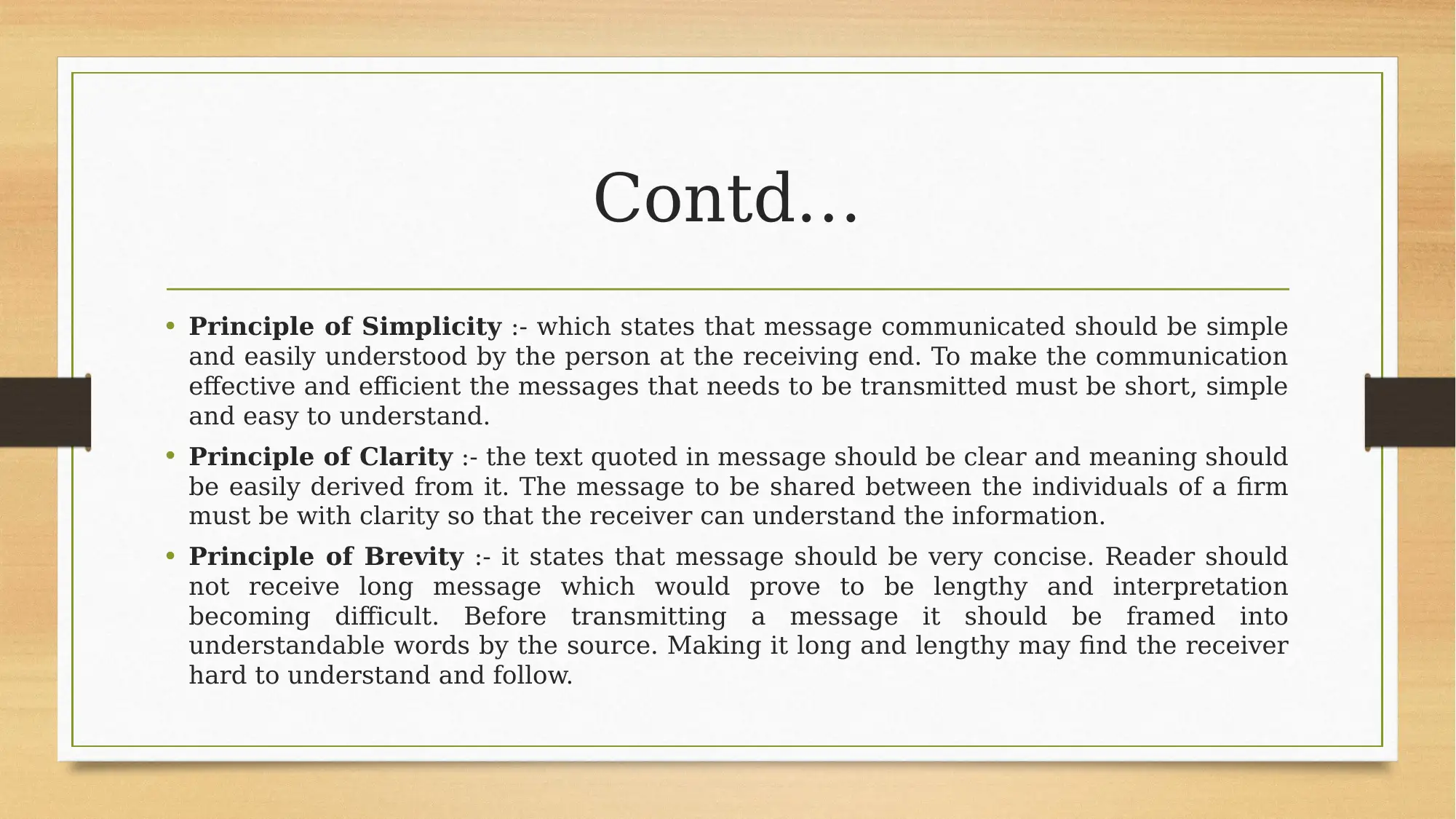
Contd…
• Principle of Simplicity :- which states that message communicated should be simple
and easily understood by the person at the receiving end. To make the communication
effective and efficient the messages that needs to be transmitted must be short, simple
and easy to understand.
• Principle of Clarity :- the text quoted in message should be clear and meaning should
be easily derived from it. The message to be shared between the individuals of a firm
must be with clarity so that the receiver can understand the information.
• Principle of Brevity :- it states that message should be very concise. Reader should
not receive long message which would prove to be lengthy and interpretation
becoming difficult. Before transmitting a message it should be framed into
understandable words by the source. Making it long and lengthy may find the receiver
hard to understand and follow.
• Principle of Simplicity :- which states that message communicated should be simple
and easily understood by the person at the receiving end. To make the communication
effective and efficient the messages that needs to be transmitted must be short, simple
and easy to understand.
• Principle of Clarity :- the text quoted in message should be clear and meaning should
be easily derived from it. The message to be shared between the individuals of a firm
must be with clarity so that the receiver can understand the information.
• Principle of Brevity :- it states that message should be very concise. Reader should
not receive long message which would prove to be lengthy and interpretation
becoming difficult. Before transmitting a message it should be framed into
understandable words by the source. Making it long and lengthy may find the receiver
hard to understand and follow.
Paraphrase This Document
Need a fresh take? Get an instant paraphrase of this document with our AI Paraphraser
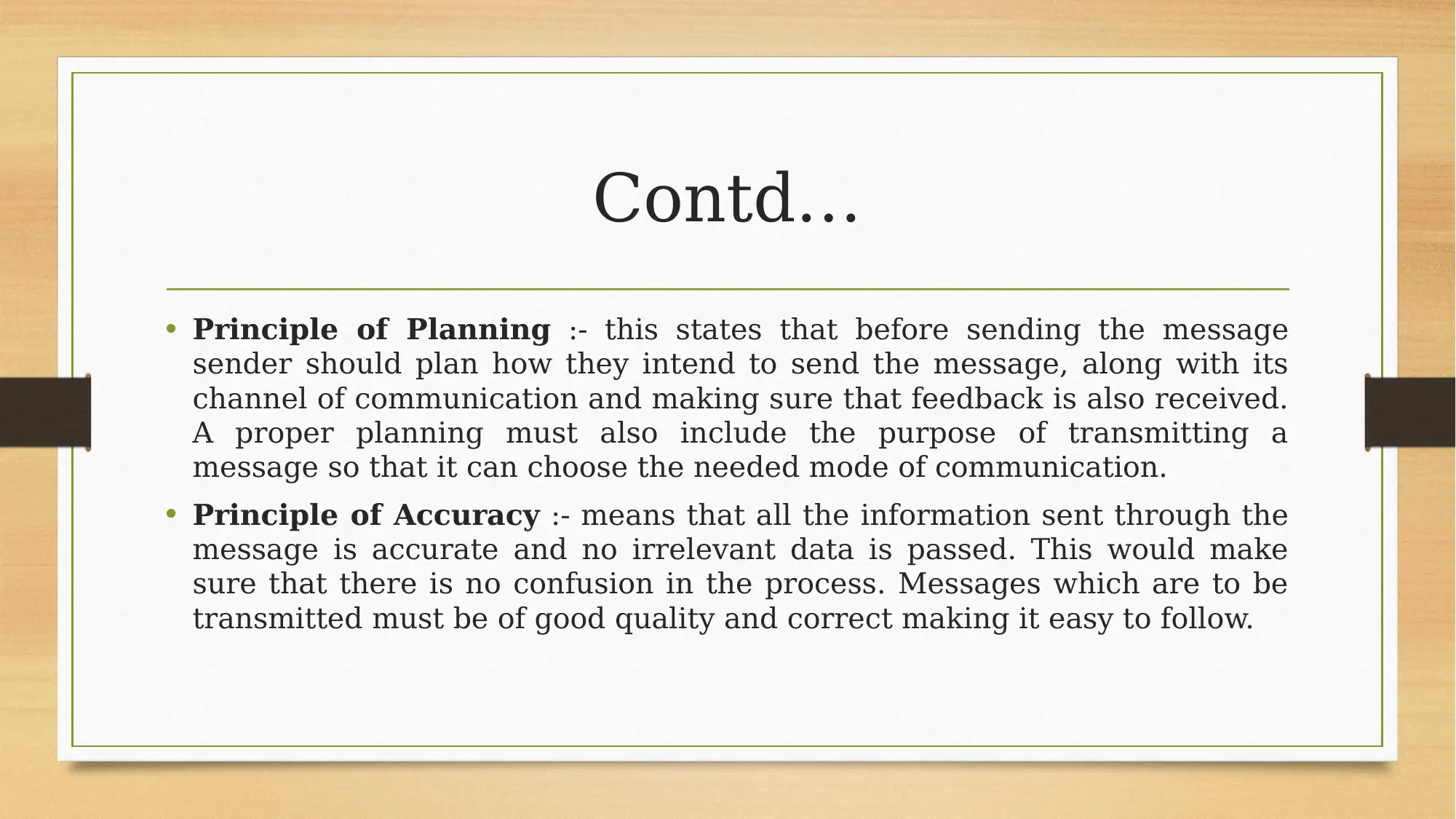
Contd…
• Principle of Planning :- this states that before sending the message
sender should plan how they intend to send the message, along with its
channel of communication and making sure that feedback is also received.
A proper planning must also include the purpose of transmitting a
message so that it can choose the needed mode of communication.
• Principle of Accuracy :- means that all the information sent through the
message is accurate and no irrelevant data is passed. This would make
sure that there is no confusion in the process. Messages which are to be
transmitted must be of good quality and correct making it easy to follow.
• Principle of Planning :- this states that before sending the message
sender should plan how they intend to send the message, along with its
channel of communication and making sure that feedback is also received.
A proper planning must also include the purpose of transmitting a
message so that it can choose the needed mode of communication.
• Principle of Accuracy :- means that all the information sent through the
message is accurate and no irrelevant data is passed. This would make
sure that there is no confusion in the process. Messages which are to be
transmitted must be of good quality and correct making it easy to follow.
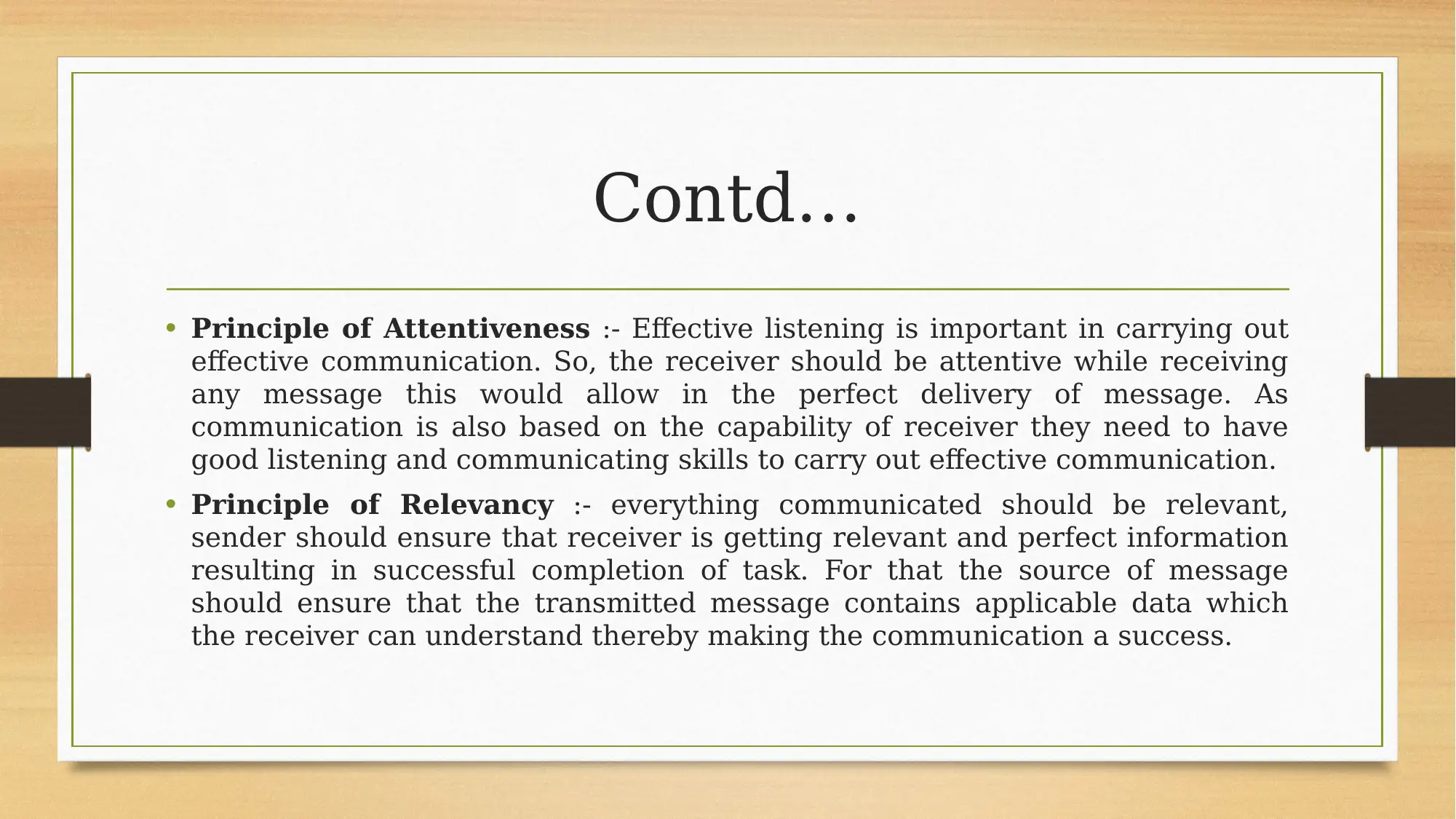
Contd…
• Principle of Attentiveness :- Effective listening is important in carrying out
effective communication. So, the receiver should be attentive while receiving
any message this would allow in the perfect delivery of message. As
communication is also based on the capability of receiver they need to have
good listening and communicating skills to carry out effective communication.
• Principle of Relevancy :- everything communicated should be relevant,
sender should ensure that receiver is getting relevant and perfect information
resulting in successful completion of task. For that the source of message
should ensure that the transmitted message contains applicable data which
the receiver can understand thereby making the communication a success.
• Principle of Attentiveness :- Effective listening is important in carrying out
effective communication. So, the receiver should be attentive while receiving
any message this would allow in the perfect delivery of message. As
communication is also based on the capability of receiver they need to have
good listening and communicating skills to carry out effective communication.
• Principle of Relevancy :- everything communicated should be relevant,
sender should ensure that receiver is getting relevant and perfect information
resulting in successful completion of task. For that the source of message
should ensure that the transmitted message contains applicable data which
the receiver can understand thereby making the communication a success.
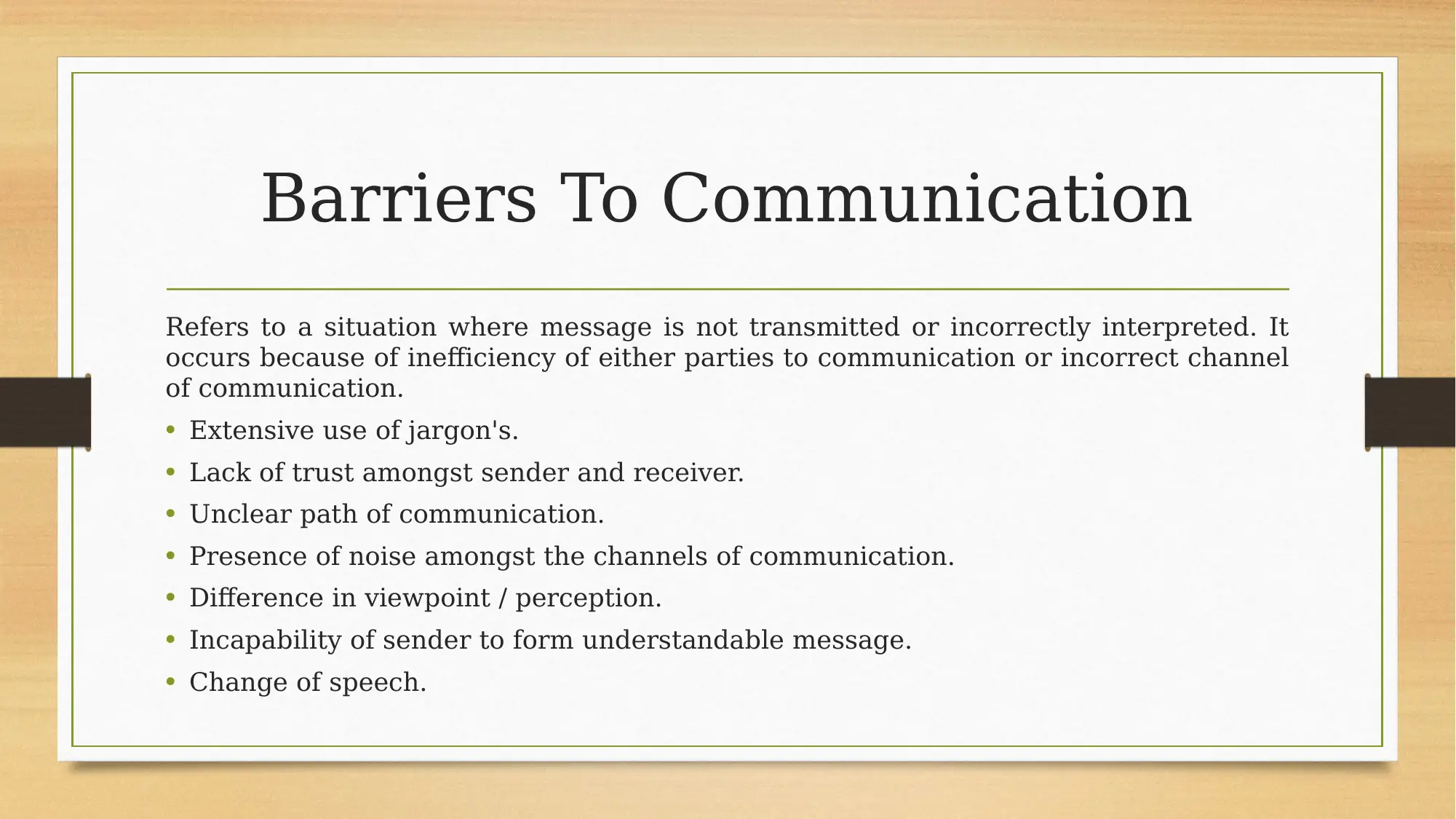
Barriers To Communication
Refers to a situation where message is not transmitted or incorrectly interpreted. It
occurs because of inefficiency of either parties to communication or incorrect channel
of communication.
• Extensive use of jargon's.
• Lack of trust amongst sender and receiver.
• Unclear path of communication.
• Presence of noise amongst the channels of communication.
• Difference in viewpoint / perception.
• Incapability of sender to form understandable message.
• Change of speech.
Refers to a situation where message is not transmitted or incorrectly interpreted. It
occurs because of inefficiency of either parties to communication or incorrect channel
of communication.
• Extensive use of jargon's.
• Lack of trust amongst sender and receiver.
• Unclear path of communication.
• Presence of noise amongst the channels of communication.
• Difference in viewpoint / perception.
• Incapability of sender to form understandable message.
• Change of speech.
Secure Best Marks with AI Grader
Need help grading? Try our AI Grader for instant feedback on your assignments.

Contd…
• Language Barriers.
• Mental disabilities.
• Cultural differences.
• Ineffective listening.
• Unable to decode message correctly.
• Not providing effective feedback.
• Wrong construction of message.
• Difficulty in understanding accents.
• Physical disabilities.
• False assumptions and stereotyping.
• Language Barriers.
• Mental disabilities.
• Cultural differences.
• Ineffective listening.
• Unable to decode message correctly.
• Not providing effective feedback.
• Wrong construction of message.
• Difficulty in understanding accents.
• Physical disabilities.
• False assumptions and stereotyping.

REFERENCES
• Bovee and Courtland, 2012. Business Communication Today, 10/e. Pearson
Education India.
• Collier, B., Blackstone, S.W. and Taylor, A., 2012. Communication access to
businesses and organizations for people with complex communication
needs. Augmentative and Alternative Communication, 28(4), pp.205-218.
• Du, S., Bhattacharya, C.B. and Sen, S., 2010. Maximizing business returns to
corporate social responsibility (CSR): The role of CSR
communication. International journal of management reviews, 12(1), pp.8-19.
• Guffey, M.E. and Loewy, D., 2012. Essentials of business communication.
Cengage Learning.
• Bovee and Courtland, 2012. Business Communication Today, 10/e. Pearson
Education India.
• Collier, B., Blackstone, S.W. and Taylor, A., 2012. Communication access to
businesses and organizations for people with complex communication
needs. Augmentative and Alternative Communication, 28(4), pp.205-218.
• Du, S., Bhattacharya, C.B. and Sen, S., 2010. Maximizing business returns to
corporate social responsibility (CSR): The role of CSR
communication. International journal of management reviews, 12(1), pp.8-19.
• Guffey, M.E. and Loewy, D., 2012. Essentials of business communication.
Cengage Learning.

Thank you
1 out of 19
Related Documents
Your All-in-One AI-Powered Toolkit for Academic Success.
+13062052269
info@desklib.com
Available 24*7 on WhatsApp / Email
![[object Object]](/_next/static/media/star-bottom.7253800d.svg)
Unlock your academic potential
© 2024 | Zucol Services PVT LTD | All rights reserved.





